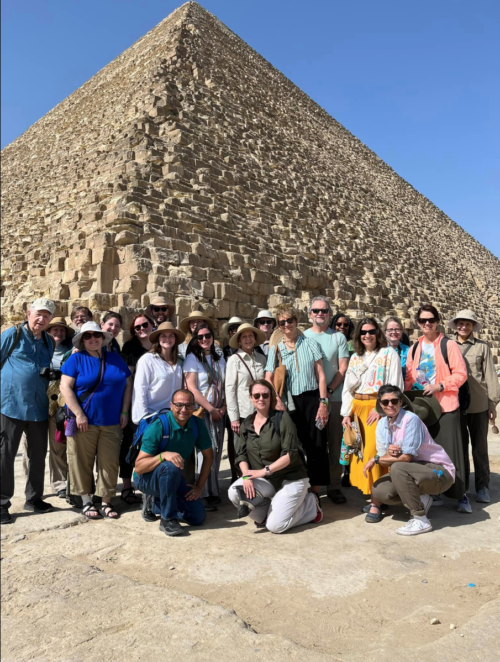Visiting The Pyramids

On our second day of the travel seminar we started our encounter of Egyptian history and culture with some of the most well-known monuments, the Great Pyramids of Giza and the Saqqara Pyramid Complex. Who would not want to see these great structures that are a few millennia old, while riding a camel roaming the desert on a sunny day? Because the Pyramids are well known people think they are familiar with them. But people who see them for the first time are usually struck by their literal and metaphorical magnitude. As one of the participants put it: being here by the pyramids feels surreal. Seeing the pyramids is, indeed, surreal with all the astonishing facts that make them a world wonder and with all the mysteries that surround the way they were built, including the new shafts and chambers that archaeologists uncover or believe they will uncover one day.
What is surreal for me about the pyramids of Giza and Saqqara is that there is always a new way of thinking about them. This time what struck me is the tension between the material and the spiritual elements involved in constructing these giant buildings. Essentially, these structures are massive tombs for the Egyptian kings who commissioned their construction. Consider the amount of resources, the intellect, and time that were put in to completing them. All of this was to guarantee the afterlife of the king. Consider all the science and rituals that were dedicated to mummifying and persevering the body of the king in order to guarantee a continuous life beyond this known reality. A successful transition into what is beyond this world, the afterlife, became a national project. This may sound ridiculous to some or an abuse of power and resources to others. But the fascination and dedication of the ancient Egyptians to the afterlife shaped the way they looked at the material world. Visiting the pyramids offers a helpful reminder to live a life in which the here-and-now and the material reality of it are in a dialectical relationship with the spiritual reality and the not-yet unfolding future.
We try to use the time on the bus to read ancient texts that relate to the sites that we visit. This day we read a passage from the Book of the Dead, a text that is part of an ancient Egyptian literary tradition that was intended to empower the deceased on their way towards the afterlife. Chapter 125 of the Book of the Dead offers a unique perspective into some of the commitments of justice and compassion that the ancient Egyptians held towards other human beings and towards non-human beings.
See, I am come before you, I have brought What is Right to you, I have removed What is Wrong for you.
I have not impoverished the divine herd (people); I have committed no crime in place of What is Right;
I have not known (explored) nothingness; I have not done any evil
I have not orphaned the orphan of his goods;
I have not caused affliction; I have not caused hunger; I have not caused grief; I have not killed; I have not harmed the offering-cattle; I have not caused pain for anyone;
I have not reduced the offerings in the temples;
I have not harmed the offering-loaves of the gods;
I have not taken the festival-loaves of the blessed dead;
I have not reduced the measuring-vessel, I have not reduced the measuring cord;
I have not encroached on the fields; I have not added to the pan of the scales;
I have not tampered with the plumb bob of the scales;
I have not taken milk from the mouths of babes;
I have not concealed herds from their pastures;
I have not snared birds in the thickets (?) of the gods;
I have not caught fish in their pools;
I have not held back water in its time;
I have not dammed a dam at rapid waters;
I have not put out the fire in its moment
—Dr. Safwat Marzouk
Associate Professor of Old Testament

